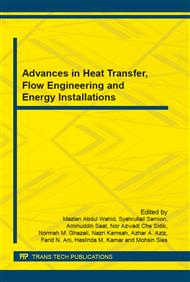[1]
L. SyamSundara, Manoj K. Singha, Antonio C.M. Sousaanvestigation of thermal conductivity and viscosity of Fe3O4 nanofluid for heat transfer applications, International Communications in Heat and Mass Transfer, volume 44, May 2013, Pages 7–14.
DOI: 10.1016/j.icheatmasstransfer.2013.02.014
Google Scholar
[2]
Koo J., Kleinstreuer C., A New Thermal Conductivity Model for Nanofluids, Journalof Nanoparticle Research, 6/ (2004), 577-588.
DOI: 10.1007/s11051-004-3170-5
Google Scholar
[3]
Yang, Y., Grulke E. A., Zhang Z. G., Wu G., Thermal and rheological properties ofcarbon nanotube-in-oil dispersions J. Appl Phys., 99(2006), 114307.
Google Scholar
[4]
Yu W., Choi S. U. S., The role of interfacial layers in the enhanced thermalconductivity of nanofluids: a renovated Maxwell model, J. nanoparticle Res, 5 (2003), 167-71.
DOI: 10.1023/a:1024438603801
Google Scholar
[5]
Walvekar R., Faris I.A., Khalid M., Thermal conductivity of carbon nanotubenanofluid-Experimental and theoretical study, Heat Transfer-Asian Research 41(2)(2012) 145-163.
DOI: 10.1002/htj.20405
Google Scholar
[6]
Wang X.Q., Mujumdar A.S., Heat transfer characteristics of nanofluids: a review, International Journal of Thermal Sciences 46 (2007) 1-19.
Google Scholar
[7]
Halelfadl S., Estellé P., Aladag B., Doner N., Maré T., Viscosity of carbonnanotubes water-based nanofluids: Influence of concentration and temperature, International Journal of Thermal Sciences, 71 (2013), 111-117.
DOI: 10.1016/j.ijthermalsci.2013.04.013
Google Scholar
[8]
Indhuja A., Suganthi K. S., Manikandan S., Rajan K. S., Viscosity and thermalconductivity of dispersions of gum arabic capped MWCNT in water: Influence ofMWCNT concentration and temperature, article in press, (2013).
Google Scholar
[9]
Yang, Y., Grulke E. A., Zhang Z. G., Wu G., Thermal and rheological properties ofcarbon nanotube-in-oil dispersions J. Appl Phys., 99(2006), 114307.
Google Scholar
[10]
Wusiman K., Jeong H., Tulugan H., Afrianto K., Chung H., Thermal performanceof multi-walled carbon nanotubes (MWCNTs) in aqueous suspensions withsurfactants SDBS and SDS, International Communications in Heat and MassTransfer, 41 (2013), 28–33.
DOI: 10.1016/j.icheatmasstransfer.2012.12.002
Google Scholar
[11]
Nasiri A., Niasar M.S., Rashidi A., Amrollahi A., Khodafarin R., Effect ofdispersion method on thermal conductivity and stability of nanofluid, ExpThermFluid Sci., 2011; 35: 717-23.
DOI: 10.1016/j.expthermflusci.2011.01.006
Google Scholar
[12]
Aladag B., Halelfadl S., Doner N., Maré T., Duret S., Estellé P., Experimentalinvestigations of the viscosity of nanofluids at low temperatures, App. Energy, 97(2012) 876-880.
DOI: 10.1016/j.apenergy.2011.12.101
Google Scholar
[13]
Estellé P., Halelfadl S., Doner N., Maré T., Shear history effect on the viscosity ofcarbon nanotubes water based nanofluid Current Nanoscience, 9/2 (2013) 225-230.
DOI: 10.2174/1573413711309020010
Google Scholar
[14]
Mahbubul I. M., Amalina M. A., Latest developments on the viscosity of nanofluids, International Journal of Heat and Mass Transfer, (/4 (2012), 874-885.
DOI: 10.1016/j.ijheatmasstransfer.2011.10.021
Google Scholar
[15]
Krieger I. M., Dougherty T.J., A mechanism for non-Newtonian flow in suspensionof rigid spheres, J. Trans. Soc. Rheol. 3 (1959) 137e152.
Google Scholar
[16]
S.H. Maron, P.E. Pierce, Application of Ree-Eyring generalized flow theory to suspensions of spherical particles,J. Colloid Sci., 11 (1956), p.80–95.
DOI: 10.1016/0095-8522(56)90023-x
Google Scholar
[17]
H. Brenner, D.W. Condiff, Transport mechanics in systems of orientable particles. Part IV. Convective transport, J. Colloid Int. Sci., 47 (1974), p.199–264.
DOI: 10.1016/0021-9797(74)90093-9
Google Scholar
[18]
Phuoc T. X., Massoudi M., Chen R. H., Viscosity and thermal conductivity ofnanofluids containing carbon nanotubes stabilized by chitosan, Int J. Thermal Sci., 50(2011), 12-18.
DOI: 10.1016/j.ijthermalsci.2010.09.008
Google Scholar
[19]
Nguyen C.T., Desgranges F., Roy G., Galanis N., Maré T., Butcher S., AngueMintsa H., Viscosity data for Al2O3 water nanofluid hysteresis: is heat transferenhancement using nanofluids reliable?, International Journal of Thermal Sciences, 47(2008).
DOI: 10.1016/j.ijthermalsci.2007.01.033
Google Scholar
[20]
Chen L, Xie H, Silicon oil based multiwalled carbon nanotubes nanofluid withoptimized thermal conductivity enhancement, Colloids and Surfaces A: Physicochemical and Engineering Aspects, 352 (2009), 136-140.
DOI: 10.1016/j.colsurfa.2009.10.015
Google Scholar
[21]
Garg P., Alvarado J. L., Marsh C., Carlson T. A., Kessler D. A., Annamali K., Anexperimental study on the effect of ultrasonification on viscosity and heat transferperformance of multi-wall carbon nanotube-based aqueous nanofluids, Int J Heat MassTransfer, 52(2009).
DOI: 10.1016/j.ijheatmasstransfer.2009.04.029
Google Scholar


